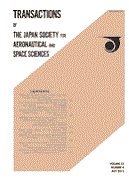Volume 67, Issue 3
Displaying 1-10 of 10 articles from this issue
- |<
- <
- 1
- >
- >|
IWAC2022 Special Issue: Selected papers from the 2022 International Workshop on ATM/CNS
-
Towards Greener Airport Surface Operations: A Reinforcement Learning Approach for Autonomous Taxiing2024 Volume 67 Issue 3 Pages 101-108
Published: 2024
Released on J-STAGE: May 04, 2024
Download PDF (1240K) -
2024 Volume 67 Issue 3 Pages 109-118
Published: 2024
Released on J-STAGE: May 04, 2024
Download PDF (2849K) -
2024 Volume 67 Issue 3 Pages 119-126
Published: 2024
Released on J-STAGE: May 04, 2024
Download PDF (1447K) -
2024 Volume 67 Issue 3 Pages 127-135
Published: 2024
Released on J-STAGE: May 04, 2024
Download PDF (1036K) -
2024 Volume 67 Issue 3 Pages 136-144
Published: 2024
Released on J-STAGE: May 04, 2024
Download PDF (2599K) -
2024 Volume 67 Issue 3 Pages 145-153
Published: 2024
Released on J-STAGE: May 04, 2024
Download PDF (6071K) -
2024 Volume 67 Issue 3 Pages 154-163
Published: 2024
Released on J-STAGE: May 04, 2024
Download PDF (7995K) -
2024 Volume 67 Issue 3 Pages 164-174
Published: 2024
Released on J-STAGE: May 04, 2024
Download PDF (2606K) -
2024 Volume 67 Issue 3 Pages 175-183
Published: 2024
Released on J-STAGE: May 04, 2024
Download PDF (888K)
-
2024 Volume 67 Issue 3 Pages 184-185
Published: May 04, 2024
Released on J-STAGE: May 04, 2024
Download PDF (35K)
- |<
- <
- 1
- >
- >|
